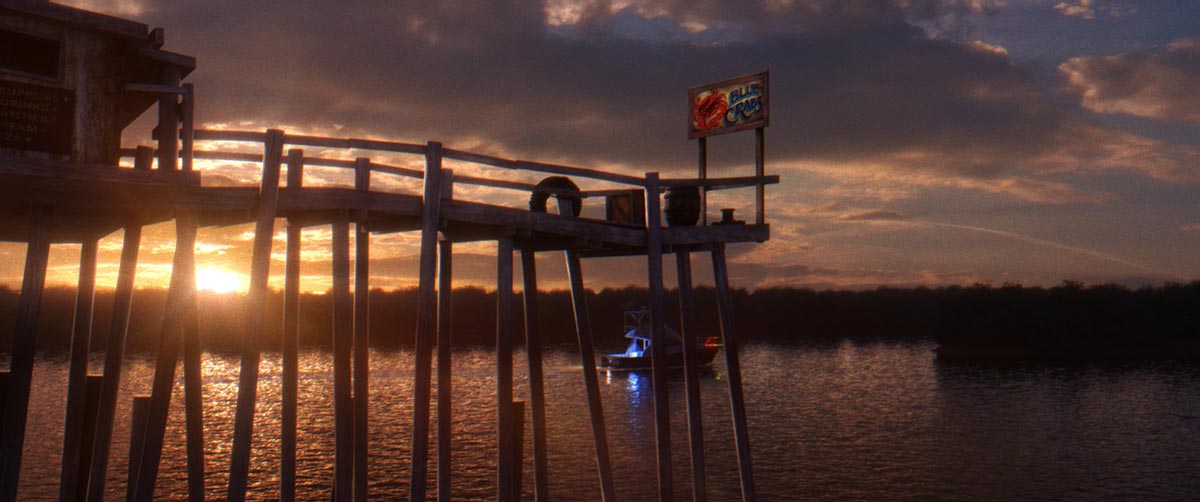Back in 2017 I went to Bournemouth England for my 2nd round as a guest speaker for the BFX Festival (https://www.bfxfestival.com). The prior year I had given a presentation of our work on “Ice Age 5 : Collision Course” (Blue Sky Studios / 20th Century FOX), and this year I had to pitch an idea that had always been, for those who know me well, part of my professional philosophy. My presentation was called “The Left Lane : The Artist as a business, independent yet connected”, and I was crossing my fingers that Bournemouth University (who puts on the BFX Festival) would find it a valuable subject for their students, and subsequently pay my way for another entertaining and engaging trip to England! The primary focus of my talk would center around how self-motivated side projects have created opportunity and why I still do them after 25 years in the industry.
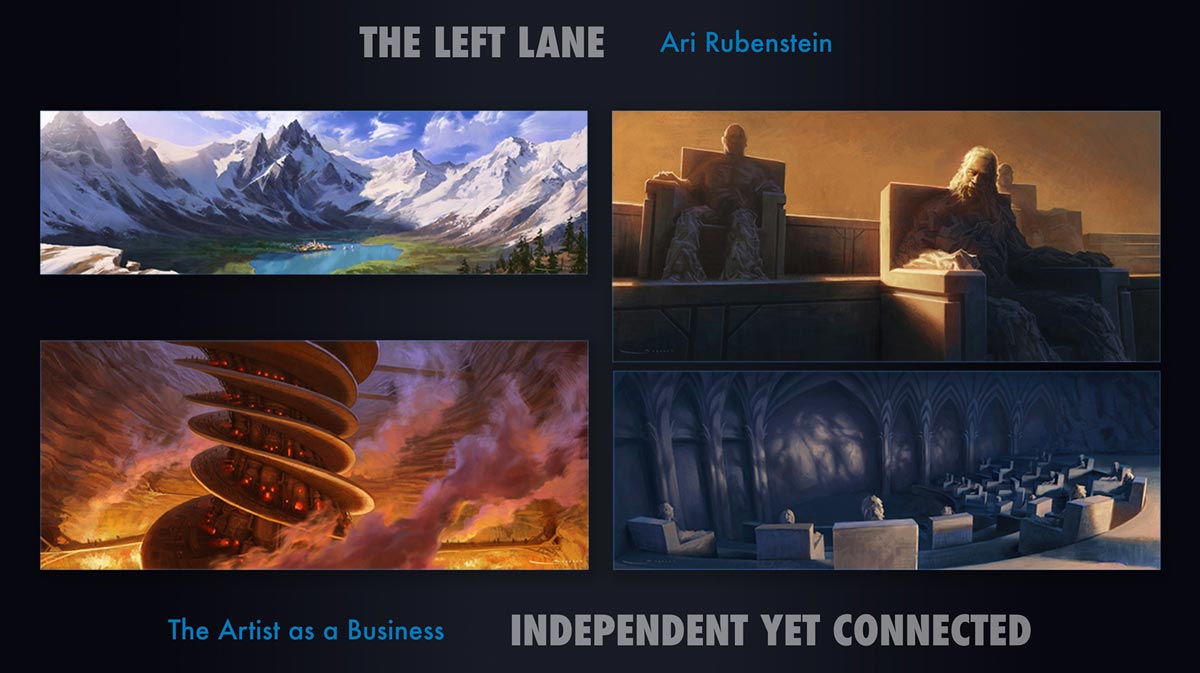

12 years prior I had moved from San Francisco where I’d been working at Tippett Studio on feature films like The Matrix Revolutions and Charlottes Web,

to New York to work for 20th Century FOX owned Blue Sky Studios. When I got to Blue Sky I was afraid that going from live action films like the Matrix to kids animated films like Ice Age would be a step down in my career. The thought being that live-action vfx is a lot more complex, at least for a compositor, than feature animation is.
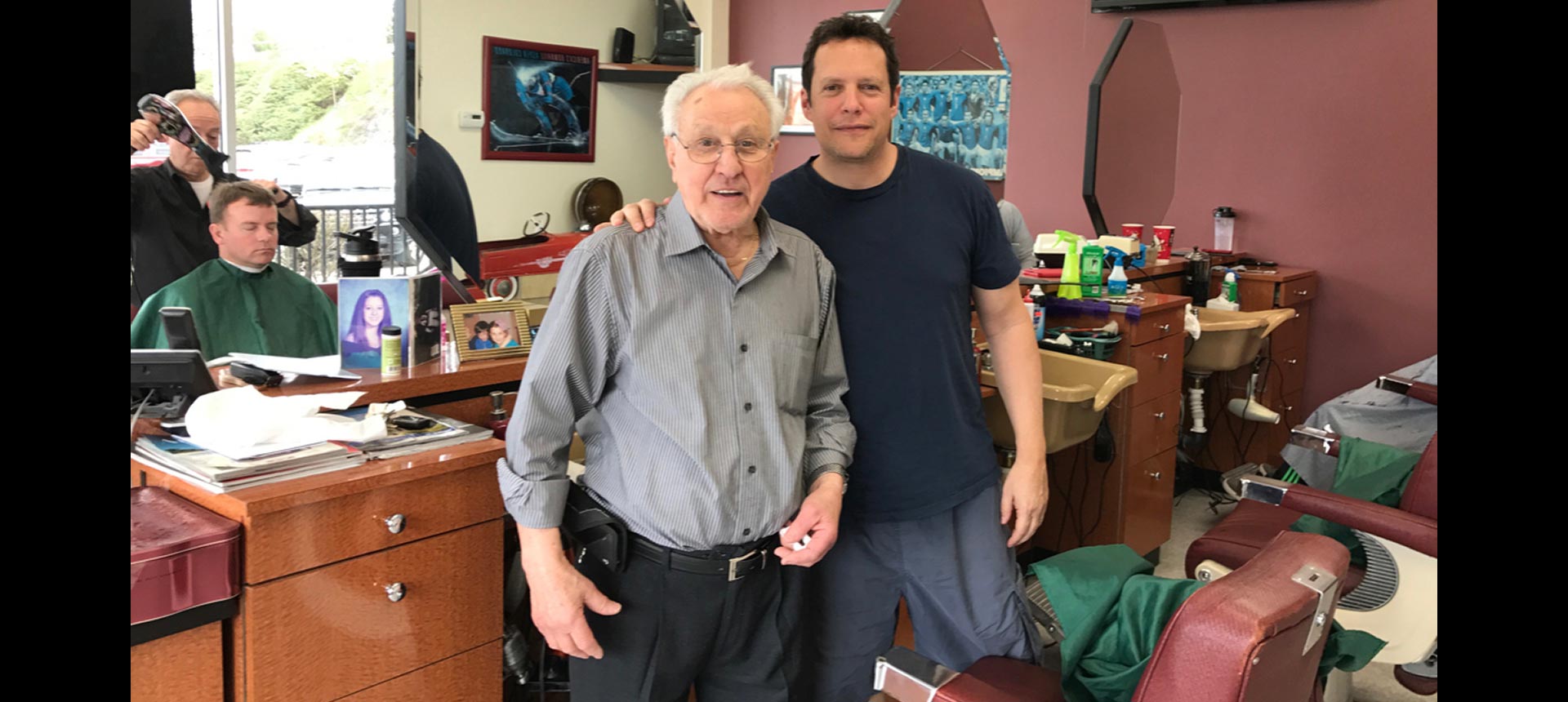
I tried to express this insecurity during a haircut at a barbershop in New York, to a distinguished older Italian man named Mario, the owner of the shop and head barber. Upon hearing of my concerns, Mario says, “yes, you need to make them all believe you’re still in the Left Lane !”. At first I didn’t understand through Mario’s thick accent, but then I gathered what he meant. That the Left Lane is the Fast Lane where everything is happening first, the edge of innovation and success! What followed was a 12 year relationship between Mario and I, where I’d go back to him each time I needed a haircut, and update him on how I was doing, using the left lane as a go-to metaphor for every joke we made about how one’s career can get de-railed if you’re not careful.

The point of the left lane is essentially that as artists we need to always remain vital and viable in our industry. And that once we relax and stop learning and innovating, we run the risk of losing our value in the market, and potentially losing the gains we’ve made. To to stay in the left lane is to always appear to be pushing the envelope, whether it’s in our own growth or ultimately, if we go far, as an industry leader.
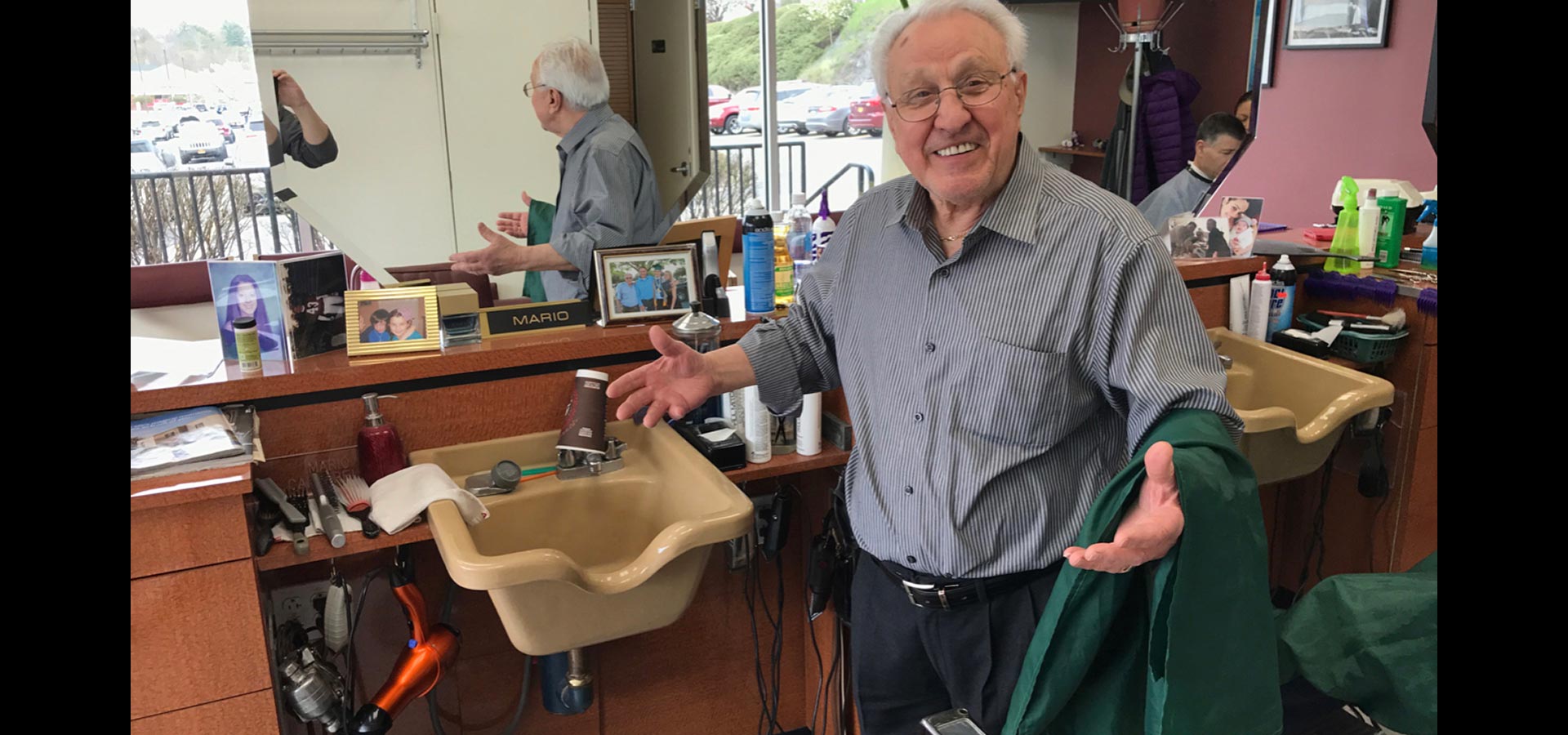
Every time I walked into the barbershop for a haircut, Mario would greet me with a big hearty “LEFT LANE”… and everyone would smile and we’d get to talking while he cut my hair. Mario became my career consigliere, an older wiser New York Italian I’m lucky to know. When I told Mario I was giving a talk titled “Left Lane” in England, he said out loud to all in the barbershop “HOLLYWOOD, I’M GOING TO HOLLYWOOD!” … I told him it was England but he knows I work in the movies, so he says “Hollywood, London, wherever, I’M GONNA BE IN THE MOVIES!”
Moving beyond Mario’s barbershop, Let’s start with the notion of demo reels. I keep mine mostly updated even at this stage in my career unlike many of my peers, whom update their reel only when they are forced to go look for a job. I like to keep mine updated so I can share with others in the industry so know I’m highly active, and motivated… that I haven’t … gone to sleep.
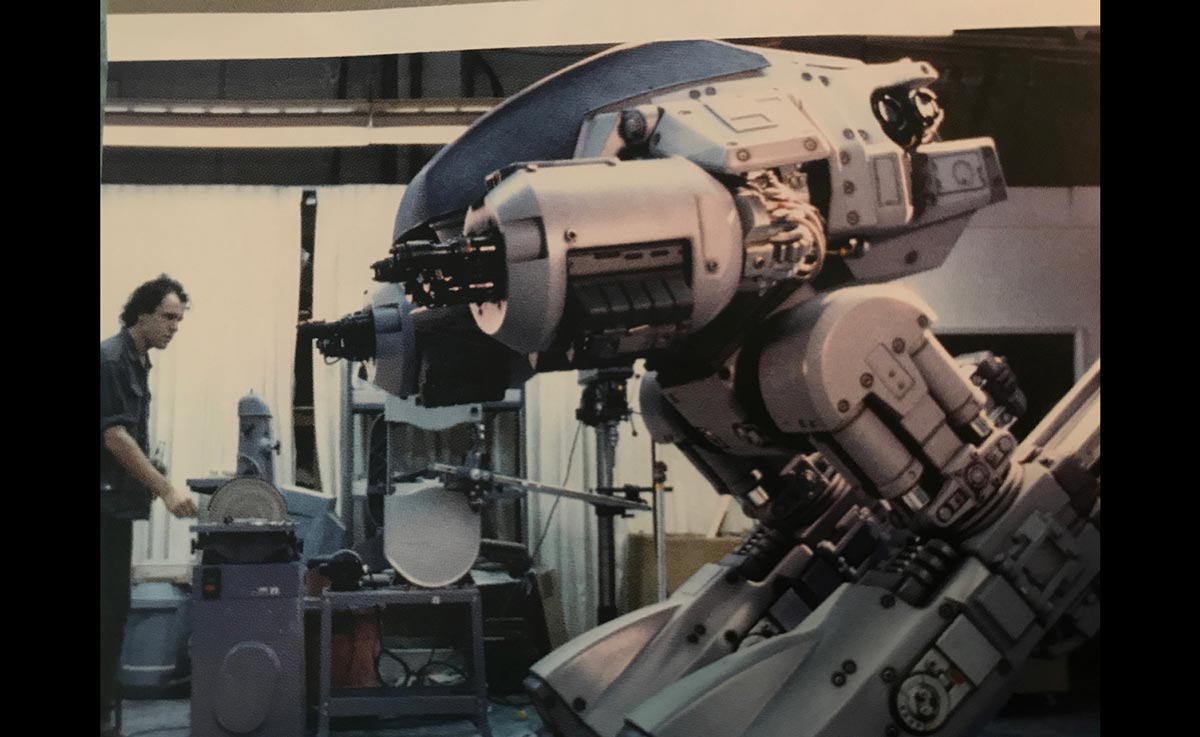
I’ve been in the CGI and VFX industry for over 25 years, starting at a time when there were no schools and very few companies to for work for. At the time, the early 90’s, my family would always say “you need to always stay one step ahead of the curve, and most importantly once you work for someone, whether it’s a short freelance job, or if you become a full time employee at a big company, find what they need to keep themselves viable in their market, and offer them that. If all you’re doing is what they’ve asked you to do when they hired you, then your value is known, and you’ll soon become dispensable to them. You need to represent what they need going forward, not what they are already competent at doing.”

And they went on “The way to create opportunity for yourself is by creating opportunity for your
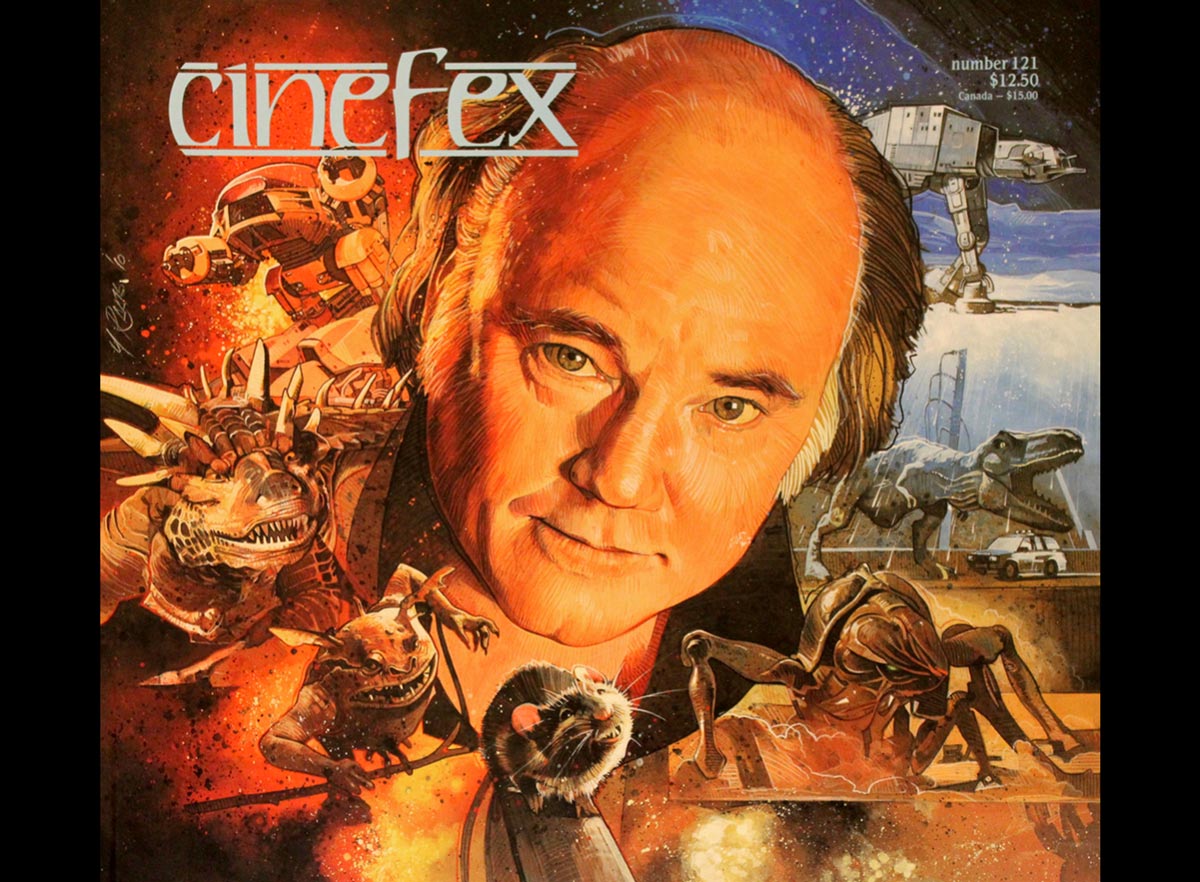
employer. Then you will be able to negotiate your value, and only then might you have leverage to do so. Think of yourself as an artist, but more importantly as a business selling your services within a market. Think of your employer as simply anyone you can get to pay you for your services. It does not need to be a big company; it could be anyone on the street … don’t limit “your” market for opportunities”.
The most important bit of advice I took away was this: “If you analyze those who are successful in your market doing what you want to do, and continue on and off the job creating the type of material they are, and updating your skills with what “their” clients ask for, you will find success and opportunity. If all you do is do what is asked of you while you’re on the job, you had better be comfortable with your current pay because it probably won’t increase much. Ask yourself, if I’m your employer and you keep giving me the same thing you gave me when we first shook hands and made the deal, and you haven’t added any new value for me, why should I ever pay you more”
It would be nice if most employers and bosses were just generous souls, but in my experience, they only pay what they have to. The free market, doesn’t give up much for free, but it does give up more for those who generate new value that can be sold for increased profits. As artists we don’t like to think about this much, and thus the reality and frequency of the starving artist! We are all part of a larger market with tremendous trading going on behind “our” workplace scene, and what they are trading is our skills as their “services”. To steal a line from the movie “Fight Club”, none of us are unique butterflies. We are but line items on a spreadsheet in business terms.
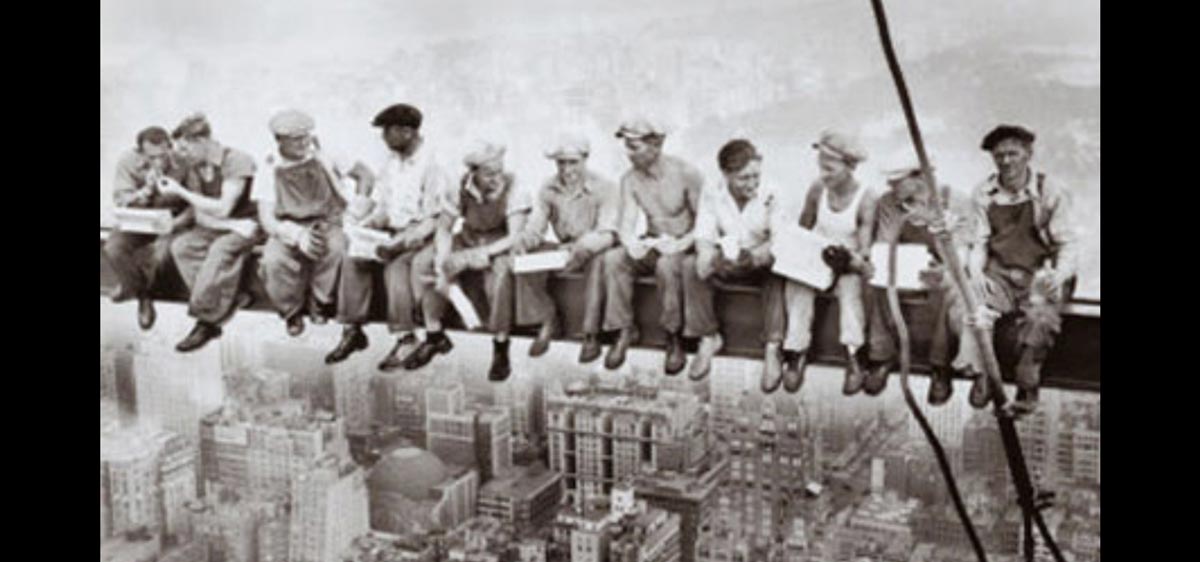
It sounds grotesque I know, but this method of trade is as old as recorded human history… I like to think of it in musical terms; learn the theory and then break out and improvise and riff on it. When I ran my company – Curv Studios – back in San Francisco, I did not treat my employees like line items, but I understood that my client’s most certainly did. Bring some ‘soul into the machine’ with whatever authority and influence you have, but in sport’s terms “know the playing field” you’re on.
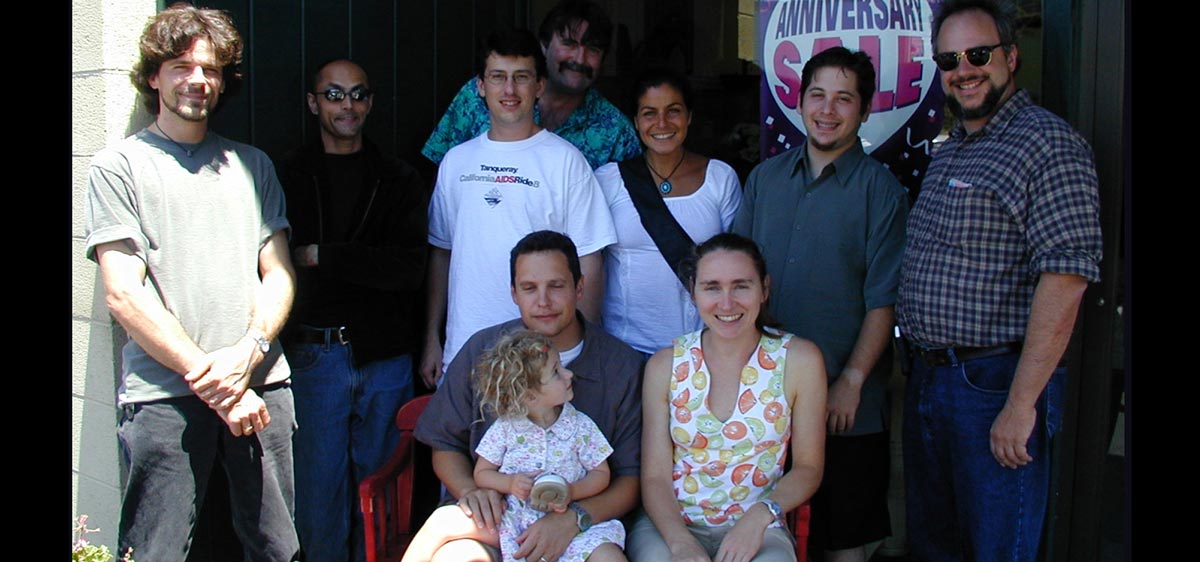
It sounds grotesque I know, but this method of trade is as old as recorded human history… I like to think of it in musical terms, learn the theory and then break out and improvise, riff on it. When I ran my company Curv Studios back in San Francisco, I did not treat my employees like line items, but I understood that my client’s most certainly did. Bring some ‘soul into the machine’ with whatever authority and influence you have, but in sport’s terms “know the playing field” your on.

Now I’d like to talk a little about “side projects”. As far as my career perspective goes, I’m always looking for ways to create opportunities, so I don’t get rutted, physically or financially. This translates into personal and commercial projects outside of my day job that fit a few criteria. It must be something I find creatively and intellectually substantial, that I learn new and valuable techniques and that it in some way holds the potential to further my career. I think it is these side projects, more so than my day jobs, which have contributed to my development as an artist.
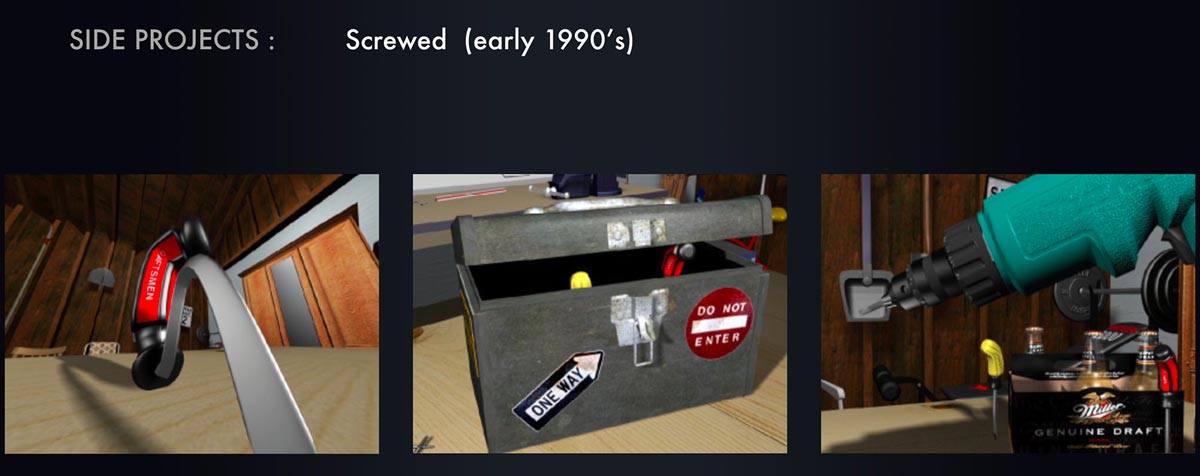
SCREWED
In the early 90’s I was doing all manner of digital freelance work in prepress and multimedia, but I wanted to break into the film industry as a VFX artist so I created this short film called “Screwed”… which probably reflected how I was feeling at the time, living in Maryland just outside of Washington DC, an area with no film work !
Created in my apartment in Maryland using 3D Studio Release 4 on DOS, and finished with 3dsMax 1.0. There were no schools which taught how to use this tool, nor was there an Internet with youtube to go find training for it. There were only book stores where insider pros sold training books for it. After creating this very primitive short film I moved out to San Francisco, and with only this short to show, got my first job at Xaos Inc. on an IMAX film. Xaos was an early CGI pioneer of particle systems and image processing technology.
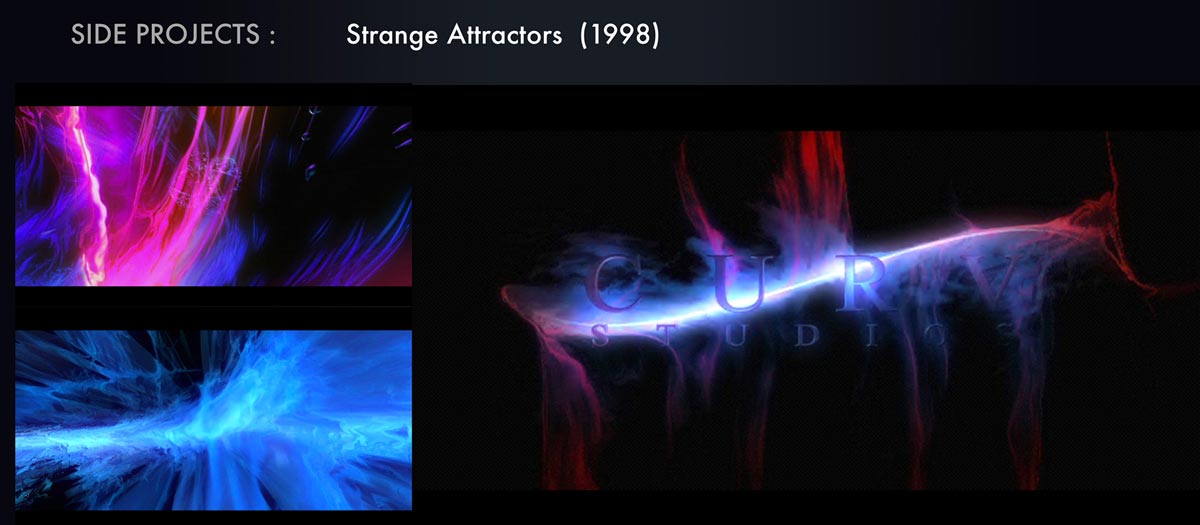
STRANGE ATTRACTORS
Once at Xaos and working among some serious industry pros I was soon trying to figure out how to differentiate myself among these seasoned artists. I decided to create an abstract exploratory piece using their proprietary particle system software and compositing techniques. This became Strange Attractors which I subsequently used to show to other prospective clients outside of Xaos for consideration of freelance contracts I soon got hired to do.
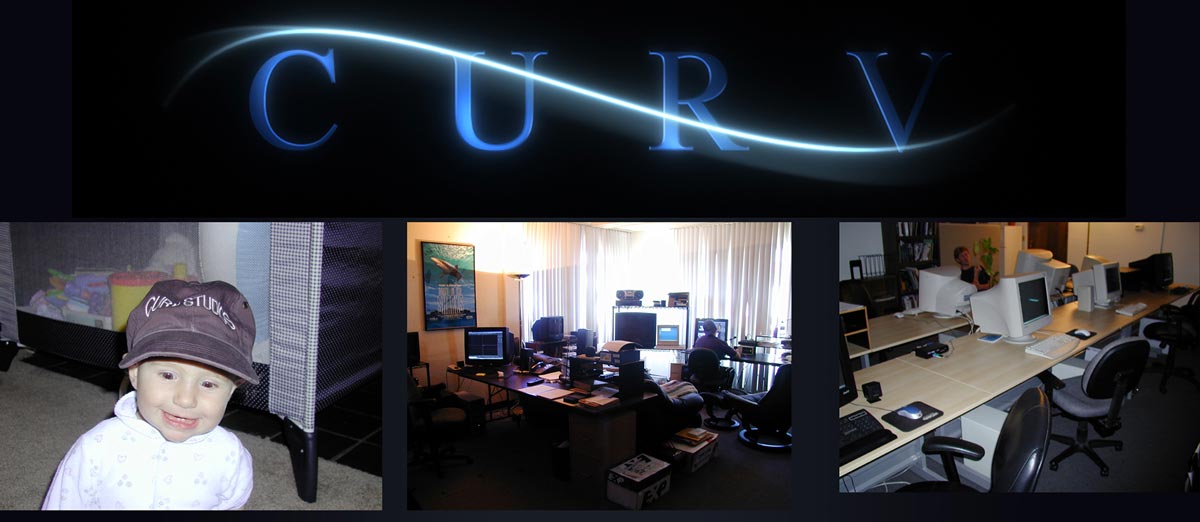
CURV STUDIOS
During my time at Xaos, since they couldn’t hire me full-time, I opened a small vfx company called Curv Studios, with an office located right around the corner from ILM in Marin Country, north of the Golden Gate Bridge. While I was having some success at Curv, I still dreamed of working on the incredible films of that day, it was the time where 3 great film trilogies were being developed… The Matrix, Lord of the Rings, and the Star Wars prequels. The type of jobs I was doing at Curv were not useful in getting me hired at any of the companies making these films so I decided to take time off to create another short form piece which might show my skills in relation to what these companies were hiring for.
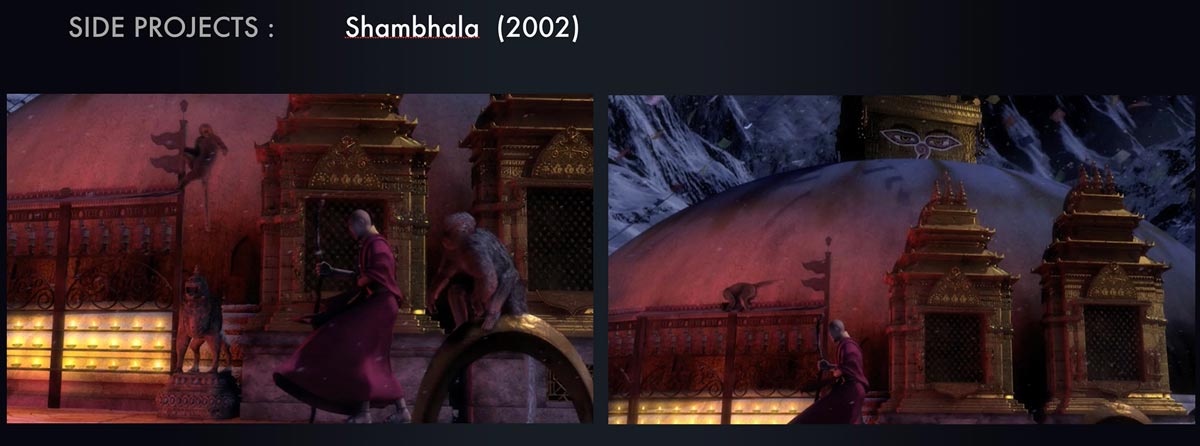
SHAMBHALA
So I developed a 20 second vfx shot called “Shambhala” using a large array of new digital tools, which eventually, after 4 months of production on it, got me hired at Tippett Studio to work on The Matrix Revolutions. Interesting to note, the VFX supervisor at Tippett was not at all impressed or interested in any of my professional work I showed, he only wanted to view this personal piece Shambhala and asked me many, many questions about it, technically and more importantly, “why” I had done it. He said it was my self motivation and vision he needed for The Matrix, and this Shambhala piece showed just that.
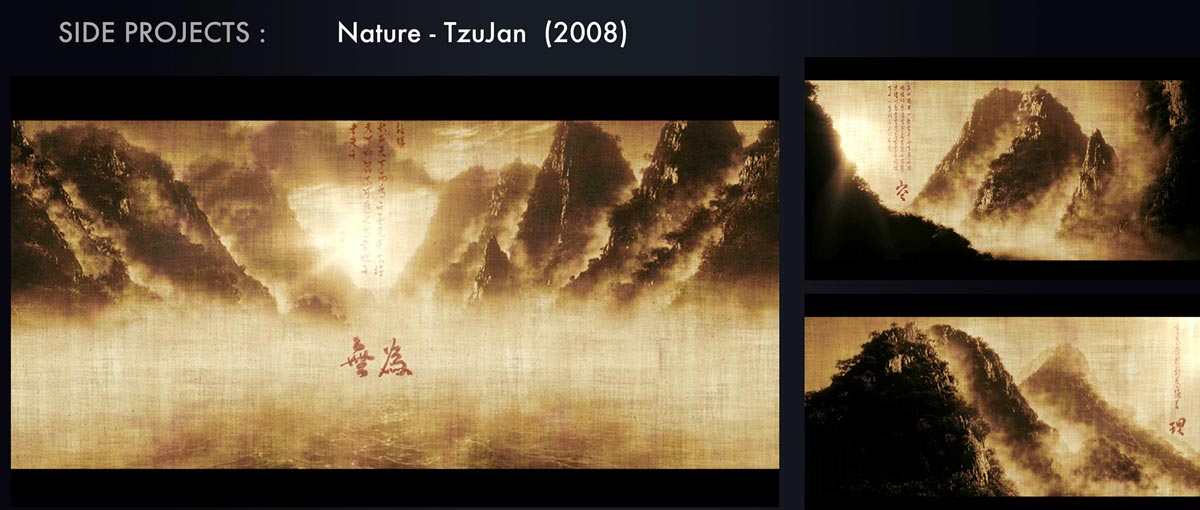
NATURE
Once I arrived at Blue Sky Studios I quickly realized they were not employing many live-action vfx techniques at all which I thought would be very useful in their films. So I created this side project called “Nature”, a study of Chinese Landscape Painting using Digital Matte Painting methods with The Foundry’s Nuke compositing application. At the time Blue Sky was using Shake, and once this piece was accepted and shown at Siggraph in 2008 I pitched the complete switch from Shake to Nuke at Blue Sky… we have been using Nuke ever since.
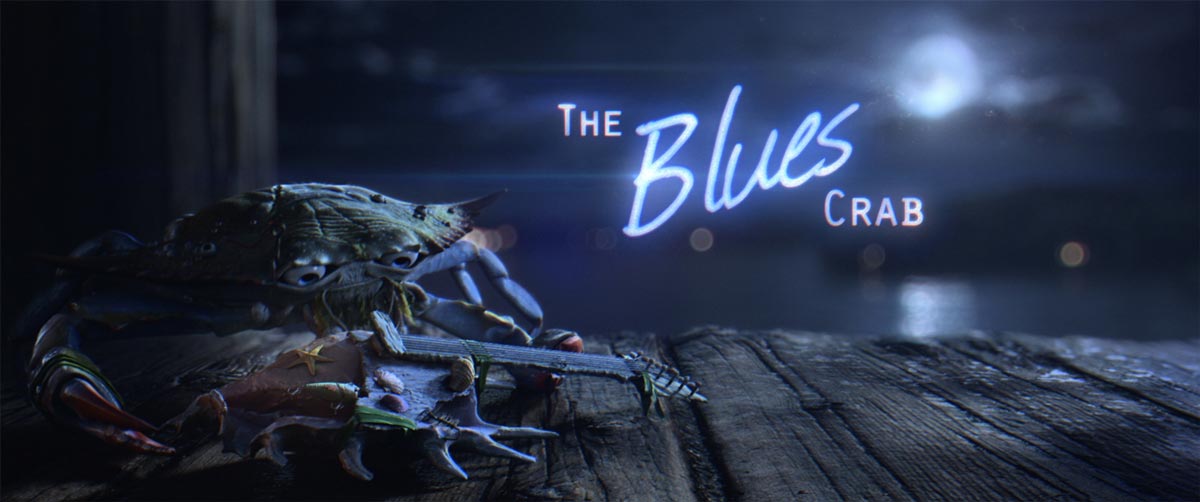
In October 2018 I wrote, Directed and produced my first 3D animated short film “The Blues Crab”. For the film I developed a remote-based VFX & Animation pipeline, subsequently managing and supervising a crew of over 60 artists spread over 15 different countries around the globe for 2 years. In addition to the creative goals of the film, I was intent on exploring how a global community of artists could effectively collaborate remotely. And to produce the film I partnered with several software developers and a cloud rendering service vendor to pull it off. The Blues Crab will have screened at over 80 film festivals globally by the end of 2019. It is half way through its festival run now and has already garnered over a dozen awards which gives me added confidence that I’m on the right track and growing as an artist, craftsman, and producer !
The Blues Crab was a loss leader for me, a passion project I needed to make but one which I’m confident will translate into further opportunities down the road. If nothing else it just re-confirms my primary philosophy, that as an artist I am also a business, producing work that keeps me viable in an ever changing marketplace. And that I need to think independently to provide continued value for whomever I work with, yet connected to them as a partner in creating produce that is mutually beneficial for all involved.
This is the key to the highway, to try and not to let anymore nail down your value in a market. Continually analyze the market and your place within it. And if you put a little soul in the machine, you’ll vitalize others and stay engaged and rewarded, regardless the tough breaks and swings of the industry.
